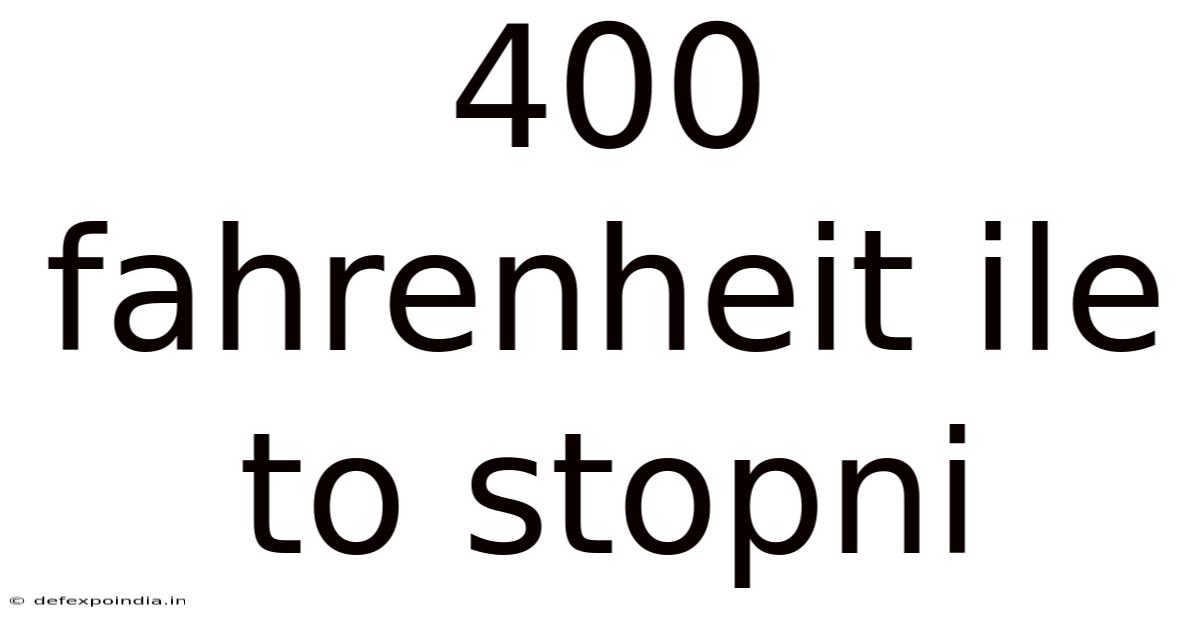400 Fahrenheit Ile To Stopni
defexpoindia
Sep 19, 2025 · 5 min read

Table of Contents
400 Fahrenheit to Celsius: A Comprehensive Guide to Temperature Conversion
Understanding temperature conversions is crucial in various fields, from cooking and baking to scientific research and industrial processes. This article provides a comprehensive guide on converting 400 degrees Fahrenheit (°F) to Celsius (°C), explaining the process, the underlying science, and offering practical applications. We'll explore the formula, demonstrate the calculation, and delve into the significance of this temperature in different contexts. We'll also address frequently asked questions to ensure a complete understanding of this essential conversion.
Introduction: The Importance of Temperature Conversions
Temperature is a fundamental physical quantity representing the degree of hotness or coldness of a substance. Different countries and industries utilize different temperature scales. The two most commonly used are Celsius (°C), also known as the centigrade scale, and Fahrenheit (°F). While Celsius is based on the freezing and boiling points of water (0°C and 100°C, respectively), Fahrenheit uses different reference points (32°F and 212°F). Accurately converting between these scales is vital for avoiding errors and ensuring consistency in various applications. This article focuses specifically on converting 400°F to its Celsius equivalent, clarifying the method and providing context for its practical significance.
Understanding the Fahrenheit and Celsius Scales
Before diving into the conversion, it's important to understand the fundamental differences between the Fahrenheit and Celsius scales.
-
Fahrenheit (°F): This scale, developed by Daniel Gabriel Fahrenheit, is primarily used in the United States and a few other countries. Water freezes at 32°F and boils at 212°F at standard atmospheric pressure.
-
Celsius (°C): This scale, also known as the centigrade scale, is the most widely used temperature scale globally. It's based on the metric system. Water freezes at 0°C and boils at 100°C at standard atmospheric pressure.
The difference between the scales stems from their different reference points and the size of their degree increments. A difference of 1°C is larger than a difference of 1°F.
The Formula for Fahrenheit to Celsius Conversion
The conversion from Fahrenheit to Celsius involves a simple, yet crucial formula:
°C = (°F - 32) × 5/9
This formula takes the Fahrenheit temperature, subtracts 32 (to account for the difference in freezing points), and then multiplies the result by 5/9 (to adjust for the different degree increments).
Converting 400°F to Celsius
Let's apply the formula to convert 400°F to Celsius:
°C = (400°F - 32) × 5/9
°C = (368) × 5/9
°C = 204.44°C (approximately)
Therefore, 400°F is approximately equal to 204.44°C.
Practical Applications of 400°F (204.44°C)
A temperature of 400°F (204.44°C) has significant implications in various fields:
-
Cooking and Baking: This temperature is commonly used in ovens for various cooking processes. Many recipes require high temperatures for achieving specific results, like roasting meats or baking certain pastries. Understanding the Celsius equivalent is essential for those using Celsius-based ovens or recipes.
-
Industrial Processes: Many industrial processes, such as heat treating metals or operating certain machinery, involve temperatures in this range. Accurate temperature control is crucial for ensuring the quality and safety of the products or processes.
-
Scientific Research: In various scientific experiments and research, precise temperature control is vital. Converting between Fahrenheit and Celsius ensures consistency and accurate data recording.
-
Material Science: Many materials exhibit specific properties at different temperatures. Understanding the equivalent Celsius temperature of 400°F is crucial in material science research and applications.
Scientific Explanation Behind the Conversion
The conversion formula is derived from the relationship between the freezing and boiling points of water on the two scales. The formula ensures a linear relationship between the two scales, meaning a consistent change in Fahrenheit corresponds to a consistent change in Celsius, albeit at a different rate. The factor 5/9 accounts for the difference in the size of the degree increments between the two scales. The subtraction of 32 accounts for the difference in the zero points of the two scales.
Frequently Asked Questions (FAQ)
-
Q: Is the conversion from 400°F to Celsius always exactly 204.44°C?
- A: The result of 204.44°C is an approximation. Depending on the precision required, more decimal places may be necessary. However, for most practical purposes, 204.44°C is a sufficiently accurate conversion.
-
Q: Why are there two different temperature scales?
- A: The existence of multiple scales reflects the historical development of thermometry and the different contexts in which temperature measurements are made. While Celsius is now internationally preferred, Fahrenheit remains prevalent in some regions.
-
Q: Are there other temperature scales besides Fahrenheit and Celsius?
- A: Yes, there are other temperature scales, including Kelvin (K), Rankine (°R), and Réaumur (°Ré). Kelvin is the absolute temperature scale, where 0 K represents absolute zero.
Conclusion: Mastering Temperature Conversions for Accuracy and Efficiency
Accurate temperature conversions are essential for clear communication and accurate results across various disciplines. Converting 400°F to its Celsius equivalent (approximately 204.44°C) showcases a practical application of the conversion formula. Understanding the underlying science, along with the practical implications of this temperature range, is crucial for professionals and individuals in many fields. This knowledge enhances efficiency and ensures accuracy in various applications, from everyday cooking to complex scientific research and industrial processes. This guide provides a solid foundation for understanding and performing temperature conversions with confidence. Remember to always double-check your calculations, especially in critical applications, and consider using online calculators for verification when needed. The ability to confidently convert between Fahrenheit and Celsius is a valuable skill in our increasingly interconnected and globally collaborative world.
Latest Posts
Related Post
Thank you for visiting our website which covers about 400 Fahrenheit Ile To Stopni . We hope the information provided has been useful to you. Feel free to contact us if you have any questions or need further assistance. See you next time and don't miss to bookmark.